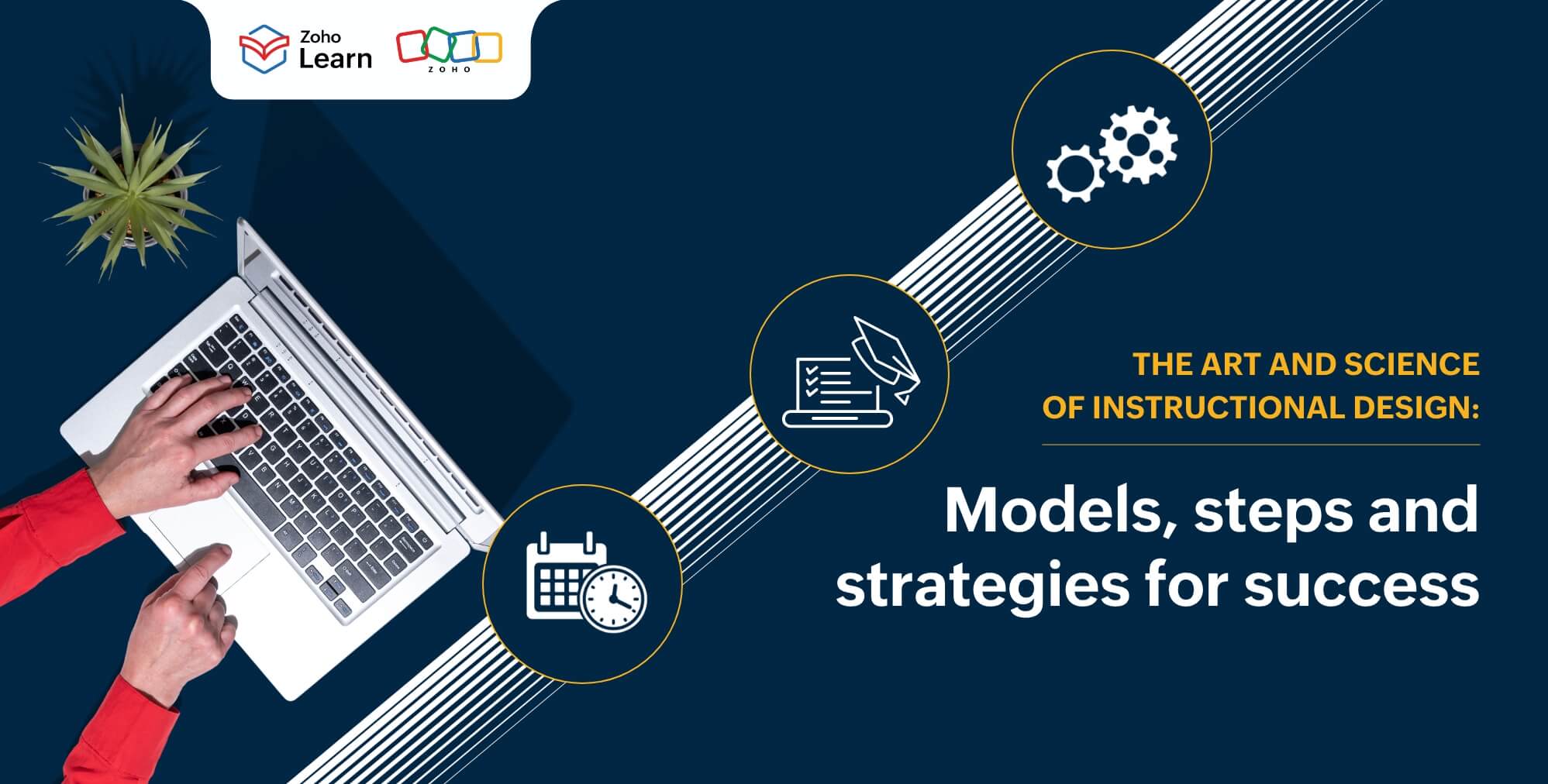The art and science of instructional design: Models, steps, and strategies for success
- Last Updated : June 30, 2025
- 310 Views
- 7 Min Read

Have you ever attended good training programs where you remember the information long after you've completed the course? You can thank the instructional designer for that.
From start to finish, instructional designers play a key role in creating immersive learning experiences. In this blog post, we’ll talk about the concept of instructional design, instructional design theories, and the steps involved in creating and designing effective courses.
What is instructional design?
Instructional design (ID) is the process of developing training materials and courses that create an immersive learning experience. Working behind the scenes, instructional designers draw practices from various fields to master the art and science of ID and build holistic courses for businesses. They rely on instructional design models to craft training that reaches all types of learners effectively.
What are the different models in instructional design?
While the majority of ID models and theories are effective and used across the world, some of the more common and popular models are discussed below.
The ADDIE model
One of the most common models of instructional design is the ADDIE model. It covers all phases of instructional design and gives you a streamlined approach to building e-learning courses. The five phases of the ADDIE model are:
Analysis: This stage involves figuring out the training goals, the target audience, and the kind of training you’ll provide.
Design: The designer prepares the basic design and lays out the structure of the course based on the results of your analysis.
Development: This is the phase where the course is actually created. Keep different kinds of learners in mind to create accessible training programs for all.
Implementation: During the implementation phase, the course is actually delivered to the learners.
Evaluation: This phase involves evaluating the course performance and gathering feedback to use for future training programs.
This purpose of this model is to follow a specific order that’s not necessarily applicable to the modern e-learning world. While all of the phases of the ADDIE model are still relevant, they can happen either simultaneously or in a random order to meet the needs of digital course instructors.
Gagne's Nine Events of Instruction
Gagne's Nine Events of Instruction is based on the behaviorist approach. By listing the nine main events for designing courses, this model acts as a blueprint for instructional designers, especially for those who are newer to the field.
The nine events are:
Gain attention.
State objectives.
Stimulate recall.
Present content.
Provide guidance.
Elicit performance.
Provide feedback.
Assess performance.
Enhance transfer and retention.
From capturing the learner's attention to ensuring that the learning is transferable to the real world, Gagne's model captures all phases of instructional design. It helps designers get an idea of the process before they start their job.
The Dick and Carey model
The Dick and Carey model provides nine interrelated components that work together to help design effective content and produce the desired results. The components in the Dick and Carey model are:
Identify goals.
Conduct analysis.
Analyze learners and contexts.
Figure out learning goals.
Create assessments.
Develop instructional strategies.
Develop instructional materials.
Conduct formative evaluation.
Conduct summative assessments.
Revise instruction as needed.
Action mapping
Action mapping is a performance-based approach that bridges the gap between real business issues and creating appropriate course instruction. This model includes four steps that focus on improving post training performance.
Identify the business goal.
Figure out what people need to do.
Design practice activities.
Identify what people need to know.
This method is highly useful for enterprises because it focuses on the actions that employees need to perform to achieve the enterprise’s business goals.
The SAM model
The SAM model of instructional design is an agile model that aims to create courses faster than previous traditional models. The three phases of the SAM model are:
Preparation.
Iterative design.
Iterative development.
The main focus of this model is its iterative nature. Because this model doesn't follow a linear path, it pushes for continual testing, feedback, and revisions.
Why is instructional design important?
It increases the quality of learning
In one scenario, you’re developing a course on cybersecurity that’s just pages and pages of definitions and details. In another, you’re developing a course on cybersecurity with real-life examples of cyberattacks and malware practices with AV and pictorial representations. This is the difference in quality of online learning programs when you involve instructional designers.
It focuses on learner engagement
One of the main roles of instructional designers is to design courses that attract the learners you want to teach. By having a clear idea of the learner profile, instructional designers can create engaging courses that are accessible to all learners. Instructional designers shift the perspective of training from a checklist item to an important engagement activity.
It fosters collaboration
Even though instructional designers are mostly responsible for course creation and delivery, it’s a role that requires collaboration between several people to provide the best learning experience possible. With a focus on learning initiatives and goals, instructional design brings together the top leaders, the HR teams, the departmental heads, and the team managers to create courses on relevant topics for each team.
It achieves the stated goals
Instructional design focuses heavily on learner engagement and experience. By curating the most suitable learning experiences, instructional designers help people achieve their learning goals. They focus on the impact the training will have at the organizational level and align the course with overall business goals, ensuring that all of the key objectives are met.
What steps do instructional designers follow?
Creating an effective learning program can be a difficult task, and the instructional designer is responsible for reducing the burden. The different steps in ID provide a structured way to create courses and enhance the learner experience.
Conduct a needs analysis.
Before you start creating courses, you must understand your company’s training needs and the kinds of learners that the course will be tailored to. Conduct an in-depth needs analysis and figure out what the key learning objectives of your organization are.
Plan the structure and design.
The next step is to identify the topic(s) you want to create courses for and plan the design accordingly. Gather all of the necessary resources and determine the different modules for the course and map out the overall flow of the content.
Focus on content creation.
This is the main step where the course content is actually created. Look into the different kinds of lessons or decide if you’re importing SCORM files. Ensure that the course content aligns with the learning objectives.
Include evaluation methods.
Ensure that you don't just provide learning material but also include different ways to test the learners’ understanding. Evaluate the content’s effectiveness using quizzes and submissions as necessary.
Host and deliver on an LMS.
One of instructional designers’ crucial roles is to choose an LMS that serves their organization's learning needs fruitfully. Choose an LMS that fits the kinds of courses you want to deliver and ensure that online learning is streamlined.
Gather feedback.
The last step is to gather feedback from the learners. Use reports to get detailed insights into their performance. Get to know the learners’ experience through course reviews and use that knowledge to make improvements.
What are the best practices on instructional design?
Develop clear learning objectives
The fundamental way to create impactful instructional design is to craft learning objectives that are clear and concise. State measurable training goals that you can quantify to analyze the course’s performance. Ensure that the training goals are evident and informed throughout the course so that your learners are aware of what's expected of them and work towards the desired outcomes.
Choose a user-friendly learning platform
Choosing the right platform to deliver your training is one of the most crucial tasks of the instructional designer because it shapes the learner experience entirely. Make sure that you choose a platform that’s intuitive and easy to understand. The aim is for the learners to access the content and controls without difficulty, and that can happen with an accessible, user-friendly LMS like Zoho Learn.
Break the information down into bite-sized chunks
The learners' response to insurmountable tasks vastly differs from a task that involves completing a module in minutes. Break your long-form content into multiple modules to make learning feel achievable for your learners. Divide your course into bite-sized lessons so that your learners will retain information better and achieve your learning objectives easily.
Be inclusive of all kinds of learners
It’s important for instructional designers to be mindful of the different kinds of learners who are going to take the course. Whether it's learners with slight cognitive or eyesight issues or simply just learners with different strengths, it's important to be inclusive of all learners and their struggles with online content. Incorporate a variety of lessons, visual elements, and real-life examples to reach all learners effectively.
Incorporate visuals for learner engagement
Don't just list pages of text in your courses because learners can and will lose interest pretty quickly. Include video lessons and visual elements to boost learners' engagement with the training. Visual learning also helps learners digest complicated information and improves retention.
Give rewards for achievements
Just like rewards push players to continue their video games, rewards and recognitions help learners stay motivated. Encourage your learners to complete their training with personalized certificates. Use gamification tactics to encourage healthy competition between learners. Give customized rewards to celebrate the achievements of your learners and push them to keep learning.
Final thoughts
From a routine task to an immersive learning experience, instructional design is the backbone to creating and delivering training programs that transform the learner journey. By mastering the art and science of instructional design, you can create courses that get lasting results. Start viewing your training programs through the lens of instructional design, and watch the quality of your learning initiatives soar.
 Kirthana V
Kirthana VA true believer of "The pen is mightier than the sword", Kirthana is a literature lover turned content writer.
With a background in Economics and English, she hopes to bring her analytical and creative side together to deliver authentic pieces of work.


